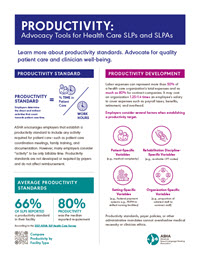Productivity
Learn more about productivity standards. Advocate for quality patient care and clinician well-being.
Productivity Standard
Productivity describes the professional’s time in patient care compared to the number of hours worked. Patient care includes direct billable services as well as indirect services that are components of comprehensive, holistic care. Productivity standards are not developed or required by payers and do not affect reimbursement.
Employers determine the direct and indirect activities that count toward patient care time. ASHA encourages employers that establish a productivity standard to include any activity required for patient care—such as patient care coordination meetings, family training, and documentation. However, many employers consider “activity” to be only billable time.

See this information in PDF format.

Productivity Development
Labor expenses can represent more than 50% of a health care organization’s total expenses and as much as 80% for contract companies. It may cost an organization 1.25–1.4 times an employee’s salary to cover expenses such as payroll taxes, benefits, retirement, and overhead.
Employers consider several factors when establishing a productivity target.
Patient-Specific Variables
(e.g., medical complexity)
Rehabilitation Discipline–Specific Variables
(e.g., available CPT codes)
Setting-Specific Variables
(e.g., federal payment systems such as the Patient Driven Payment Model in skilled nursing facilities)
Organization-Specific Variables
(e.g., proportion of salaried staff to contract staff)
Productivity standards, payer policies, or other administrative mandates cannot overshadow medical necessity or clinician ethics.
Average Productivity Standards

Source: 2025 ASHA SLP Health Care Survey [PDF]
You can explore productivity information for your setting, including reported productivity level and the clinical services that are included, using this interactive tool. You can maximize the tool for use in a new window by clicking the icon the bottom right corner.
How to Influence Productivity
Here are some suggestions and strategies for talking about productivity with your organization.
Get to know your organization.
- How does your organization calculate productivity?
- Is your employer for-profit or non-profit? What is your supervisor’s professional background? With which insurance companies does your organization contract?
- What is the turnover or vacancy rate for clinicians? What is the relationship between high productivity requirements and professional burnout?
- Are there active quality improvement initiatives that require your time?
Show how you spend your time.
Capture all of the activities required to effectively manage your caseload. Think about additional activities beyond documentation—for example, team meetings, staff trainings, and care coordination activities.
Know how your productivity stacks up.
Review ASHA’s Health Care Survey: Practice Trends. Compare your organization’s standard to that of other organizations in a similar setting. Optimize varied service delivery when it’s clinically appropriate.
Demonstrate your value.
Gather information about how your services help prevent hospitalizations, shorten length of stay, reduce re-admissions, impact patient-reported outcomes and satisfaction ratings, and support compliance.
Know your rights as an employee.
Talk to your human resources department or labor attorney if your organization pressures you to work “off the clock.” The Fair Labor Standards Act protects non-exempt employees from feeling required to complete job tasks outside of contracted hours to meet an organization’s unreasonable productivity standards.
Defend the importance of using clinical judgment [PDF], and understand your reporting obligations [PDF] to corporate compliance if you identify employee rights issues.









